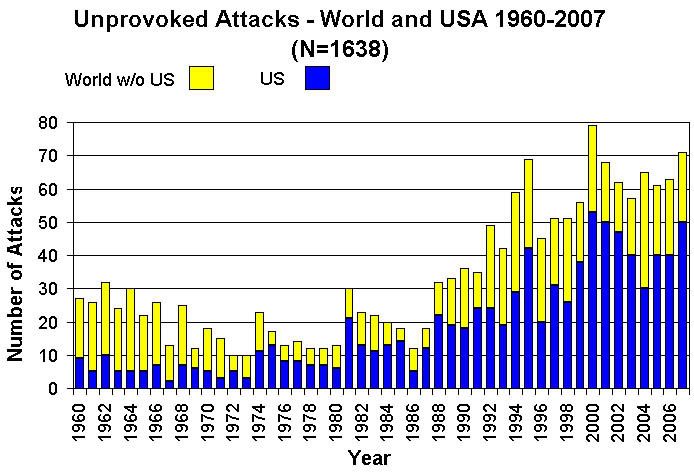
Above: Unprovoked shark attack trend comparisons for the World (Yellow) and the United States (Blue) from 1960-2007 from the International Shark Attack Files. View shark attack listing by state.
Shark attacks have been one of the horror story of the seas. Documented attacks on servicemen during World War II prompted the Office of Naval Research to initiate funding of a shark-related research program in 1958 as part of the quest to find an effective shark repellent. (Read more…)
When I was a young upstart studying the marine world, Eugene Clark (aka the Shark Lady) discovered that the delicate Moses Sole (Pardachirus marmoratus) secreted a milky, astringent substance from the base of its dorsal and anal fin spines. Because Pardachirus was a slow mover, she theorized that this was a protective toxin.
She was right and laboratory and open ocean tests revealed that, among other things, it repelled at least four species of sharks for 10 hours or longer.
Later tests were done with sodium lauryl sulfate (SLS) and lithium lauryl sulfate (LLS) and sodium dodecyl sulfate (SDS) and all were found to be effective–and imagine–all of these are common ingredients in soap!
So, how does soap repel a shark?
The ingredients attack the fatty molecules of cell membranes in a shark’s delicate gill filaments which causes a massive influx of sodium ions from the surrounding seawater. This ionic influx is clearly highly distressing to many sharks. (Read more…)
Today shark deterrents are chemical, electrical, magnetic, or a combination. There are a variety of products on the market:
Shark Shield works by using a repellent electric field that induces spasms in the sharks’ snouts. You might want to read about these kayakers who used this shark repellent successfully.
Read more about Aerosol SD-1, Electrochemicals, and other repellents.
Check out Shark Attacks of the Twentieth Century: From the Pacific Coast of North America or visit:
Click here if you need to report a shark attack.

